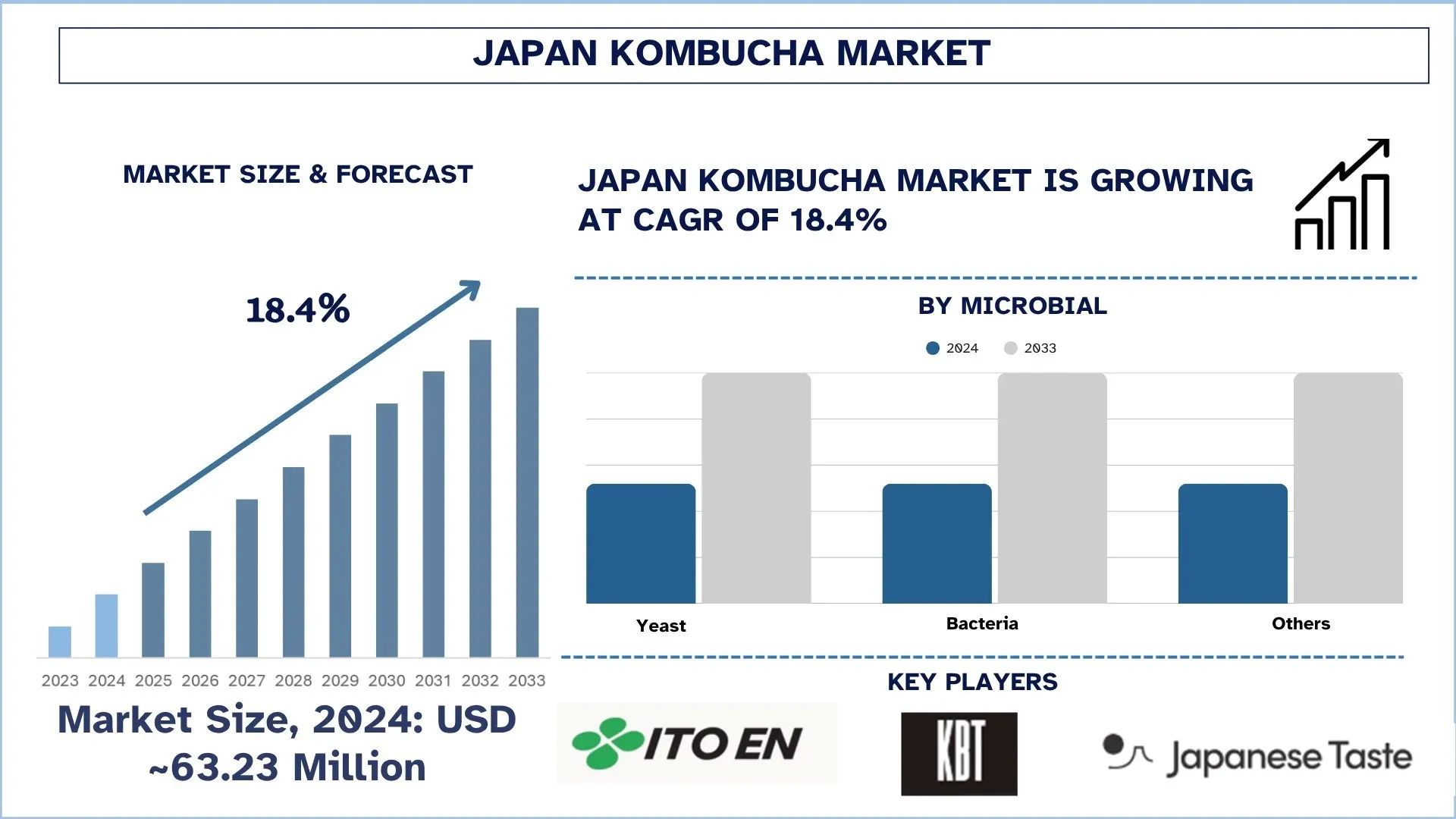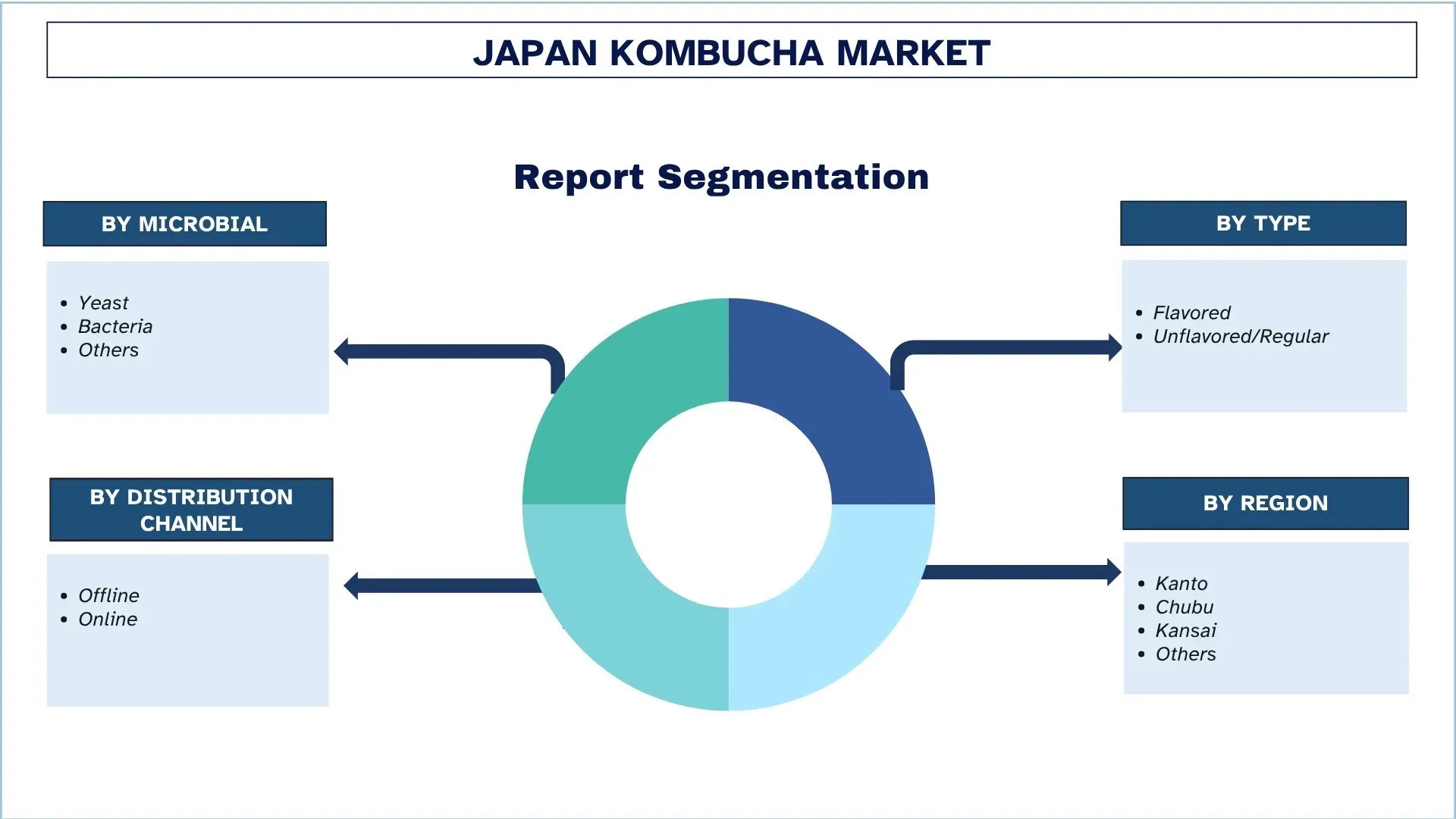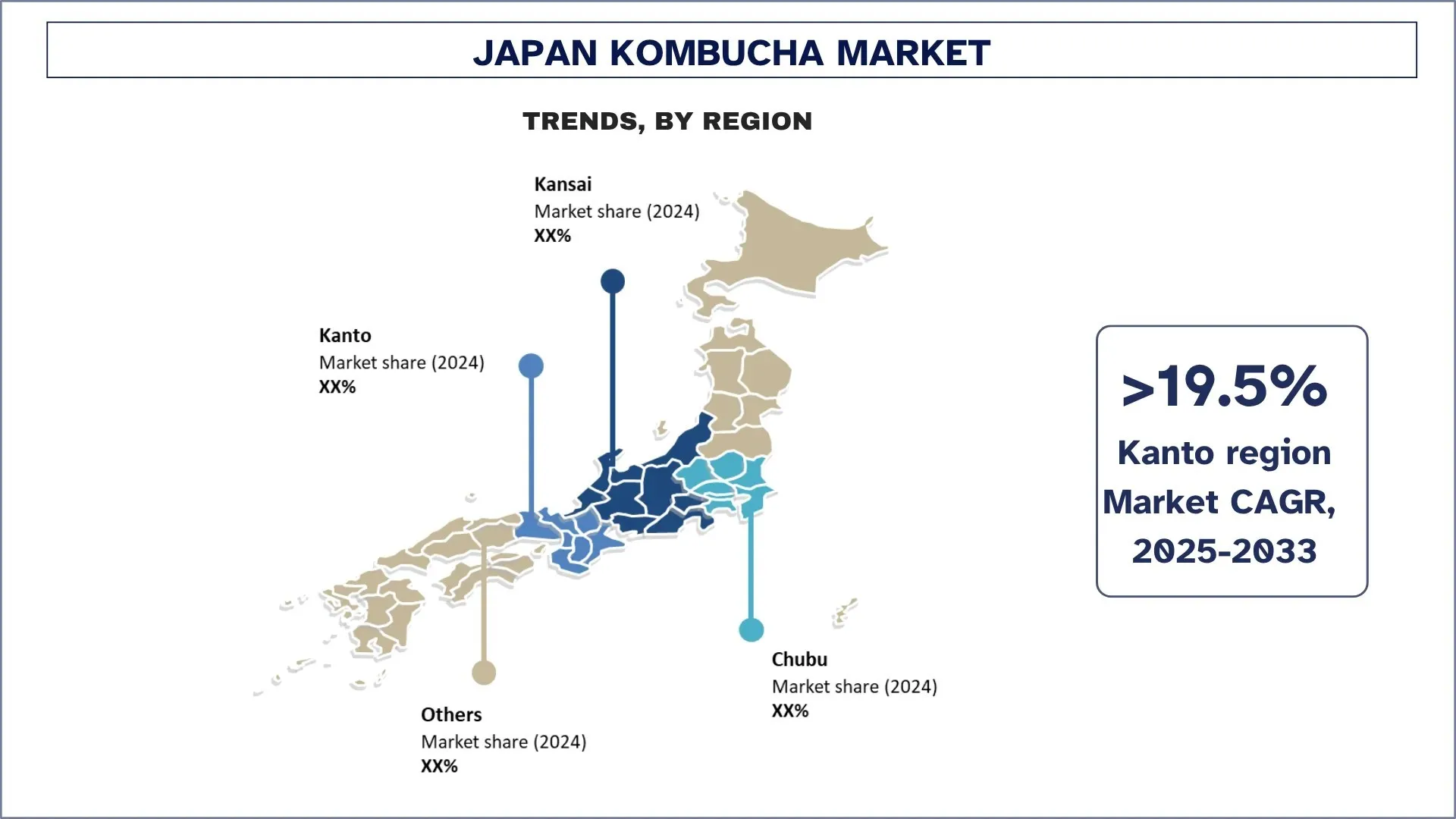- Home
- About Us
- Industry
- Services
- Reading
- Contact Us
Japan Kombucha Market: Current Analysis and Forecast (2025-2033)
Emphasis By Microbial (Yeast, Bacteria, Others), By Type (Flavored, Unflavored/Regular), by Distribution Channel (Offline, Online), By Region

Japan Kombucha Market Size & Forecast
The Japan Kombucha market was valued at USD 63.23 million in 2024 and is expected to grow to a strong CAGR of around 18.4% during the forecast period (2025-2033F), owing to the rising demand from young customers.
Japan Kombucha Market Analysis
Kombucha production is actively developing in Japan, where consumers are getting more aware of their gut and functional drinks. With Japan still emphasizing wellness and clean labels, kombucha has become a sought-after option when it comes to the consumption of probiotics-rich foods. The market, which was initially niche, is currently rapidly growing as the local brands join the trend to compete with foreign brands. Some of the major urban centers, like Tokyo and Osaka, are turning into hotspots of kombucha cafes and retail products. As Japanese consumers take a keen interest in fermented products, the kombucha category is experiencing the combination of favorable cultural affinity and interest and demand in non-alcoholic, health-based alternatives to continue innovation and constant product diversification.

Japan Kombucha Market Trends
This section discusses the key market trends that are influencing the various segments of the Japan Kombucha market, as found by our team of research experts.
Hard Kombucha & Low‑Alcohol Offerings:
The increase in low alcohol and alternative alcohol beverages is opening new possibilities for hard kombucha in Japan. The alcohol content in hard kombucha is usually 3-7%, and it is targeted at the health-conscious clientele seeking a lighter alcoholic drink compared to beer or spirits. It takes the perceived health properties of kombucha, including probiotic and natural character, and mixes it with the social factor of alcohol.
This mixture particularly applies to the younger adults in the range of decreasing their intake of alcoholic beverages, yet they are still determined to take part in social drinking. People with changing lifestyle habits were midway between hard and non-alcoholic, so hard kombucha falls in the middle.
Still a minor category in Japan, hard kombucha is receiving traction in lifestyle bars, health-oriented cafes, and premium stores. Increased growth in this region is possible once the producers add local preferences in terms of laces and meet the local regulations.
All in all, the hard kombucha concept is one that will allow the kombucha market to expand the purpose of consumption beyond the health and wellness sector into the non-medical context of recreational consumption.
Japan Kombucha Industry Segmentation:
This section provides an analysis of the key trends in each segment of the Japan Kombucha market report, along with forecasts at the country and regional levels for 2025-2033.
The Yeast Category has shown promising growth in the Kombucha Market.
The market has been segmented into yeast, bacteria, and others on the basis of the Microbial segment. Among these, the yeast segment has been enjoying a significant market share due to the fermentation role it plays in kombucha and the development of the taste. The yeast not only makes it carbonated but also helps in giving it its signature tangy flavor that consumers prefer. Moreover, the product consistency and its health consequences have been improved by veterinarian-strain selection together with controlled fermentation procedures. This segment is likely to remain as strong as ever because of ongoing experimentation by brands on the different strains of functional yeast in premium and craft kombucha products that are aimed at targeting health-conscious customers.
Flavored Kombucha Category Dominates the Japan Kombucha Market.
The market is segmented into flavored and unflavored/regular on the basis of type. Out of these, the flavored market segment has been having the largest proportion range, characterized by the culture of variation and taste enrichment in consumers. Popular tastes like lemon, ginger, berry, yuzu, and matcha have gotten a wider following, particularly among the younger consumers. The demand has been further increased by the availability of seasonal and regionally derived flavoring. Also, flavor innovation has moved as a major point of differentiation between brands, which leads to repeat purchases.
Kanto is expected to grow at a considerable rate during the forecast period.
Kanto region, which hosts Tokyo and the most populous metropolitan area in Japan, is one of the major growth centers in the Kombucha market. There is an abundant health-savvy population and a vibrant cafe culture; therefore, there is a following of kombucha among the young and millennial generations. Specialty health stores, organic supermarkets, and urban cafes have started to carry both local and foreign bottled kombucha brands. The local manufacturers are employing the creation of new flavors, like yuzu, matcha, and shiso, to suit local tastes. There is also the emergence of trendy kombucha breweries and wellness places or pop-ups in Kanto that can be considered a sign of increasing interest in natural, probiotic drinks as a component of a healthy diet and lifestyle.

Japan Kombucha Industry Competitive Landscape:
The Japan Kombucha market is competitive, with several global and international market players. The key players are adopting different growth strategies to enhance their market presence, such as partnerships, agreements, collaborations, new product launches, geographical expansions, and mergers and acquisitions.
Top Japan Kombucha Companies
Some of the major players in the market are Ito En, Suntory, KBT Kombucha Brewery Tokyo, Suntory, OKS Company, Expandy Co. Ltd (Japanese Taste), YUWA CO., LTD, Asahi Beverages, GYOKUROEN, Wow-Food Inc., and Toyo Kombucha.
Japan Kombucha Market Report Coverage
Details | |
Base year | 2024 |
Forecast period | 2025-2033 |
Growth momentum | Accelerate at a CAGR of 18.4% |
Market size 2024 | USD 63.23 Million |
Regional analysis | Kanto, Chubu, Kansai, and Others |
Major contributing region | Kanto is expected to dominate the market during the forecast period. |
Companies profiled | Ito En, Suntory, KBT Kombucha Brewery Tokyo, OKS Company, Expandy Co. Ltd (Japanese Taste), YUWA CO., LTD, Asahi Beverages, GYOKUROEN, Wow-Food Inc., and Toyo Kombucha |
Report Scope | Market Trends, Drivers, and Restraints; Revenue Estimation and Forecast; Segmentation Analysis; Demand and Supply Side Analysis; Competitive Landscape; Company Profiling |
Segments Covered | By Microbial, By Type, By Distribution Channel, by Region |
Reasons to Buy the Japan Kombucha Market Report:
The study includes market sizing and forecasting analysis confirmed by authenticated key industry experts.
The report briefly reviews overall industry performance at a glance.
The report covers an in-depth analysis of prominent industry peers, primarily focusing on key business financials, type portfolios, expansion strategies, and recent developments.
Detailed examination of drivers, restraints, key trends, and opportunities prevailing in the industry.
The study comprehensively covers the market across different segments.
Deep dive regional-level analysis of the industry.
Customization Options:
The Japan Kombucha market can further be customized as per the requirements or any other market segment. Besides this, UnivDatos understands that you may have your own business needs; hence, feel free to contact us to get a report that completely suits your requirements.
Table of Content
Research Methodology for the Japan Kombucha Market Analysis (2023-2033)
We analyzed the historical market, estimated the current market, and forecasted the future market of the Japan Kombucha market to assess its application in major regions. We conducted exhaustive secondary research to gather historical market data and estimate the current market size. To validate these insights, we carefully reviewed numerous findings and assumptions. Additionally, we conducted in-depth primary interviews with industry experts across the Kombucha value chain. After validating market figures through these interviews, we used both top-down and bottom-up approaches to forecast the overall market size. We then employed market breakdown and data triangulation methods to estimate and analyze the market size of industry segments and sub-segments.
Market Engineering
We employed the data triangulation technique to finalize the overall market estimation and derive precise statistical numbers for each segment and sub-segment of the Japan Kombucha market. We split the data into several segments and sub-segments by analyzing various parameters and trends, By Microbial, By Type, By Distribution Channel, and By regions within the Japan Kombucha market.
The Main Objective of the Japan Kombucha Market Study
The study identifies current and future trends in the Japan Kombucha market, providing strategic insights for investors. It highlights regional market attractiveness, enabling industry participants to tap into untapped markets and gain a first-mover advantage. Other quantitative goals of the studies include:
Market Size Analysis: Assess the current forecast and market size of the Japan Kombucha market and its segments in terms of value (USD).
Japan Kombucha Market Segmentation: Segments in the study include areas By Microbial, By Type, By Distribution Channel, and By
Regulatory Framework & Value Chain Analysis: Examine the regulatory framework, value chain, customer behavior, and competitive landscape of the Japan Kombucha industry.
Regional Analysis: Conduct a detailed regional analysis for key areas such as Kanto, Chubu, Kansai, and Others.
Company Profiles & Growth Strategies: Company profiles of the Japan Kombucha market and the growth strategies adopted by the market players to sustain the fast-growing market.
Frequently Asked Questions FAQs
Q1: What is the Japan Kombucha market’s current market size and growth potential?
The Japan Kombucha market was valued at USD 63.23 Million in 2024 and is expected to grow at a CAGR of 18.4% during the forecast period (2025-2033).
Q2: Which segment has the largest share of the Japan Kombucha market by Microbial?
The yeast segment has been enjoying a significant market share due to the fermentation role it plays in kombucha and the development of the taste.
Q3: What are the driving factors for the growth of the Japan Kombucha market?
• Rising Health-Consciousness & Probiotic Demand: Increasing consumer focus on gut health and immunity is boosting kombucha’s appeal as a natural functional beverage.
• Functional Beverage Trend & Fermented Foods Popularity: Growing interest in fermented foods and beverages supports kombucha market expansion.
Q4: What are the emerging technologies and trends in the Japan Kombucha market?
• Flavor Innovation & Premiumization: Brands are launching new flavors and premium products to meet evolving consumer tastes.
• Hard Kombucha & Low-Alcohol Offerings: Rising demand for low-alcohol alternatives fuels the growth of hard kombucha in social settings.
Q5: What are the key challenges in the Japan Kombucha market?
• Limited Consumer Awareness & Taste Barriers: Kombucha remains niche due to unfamiliarity and flavor preferences limiting mass adoption.
• Production Costs, Regulatory & Supply-Chain Constraints: High manufacturing expenses and strict regulations hinder scalability and price competitiveness.
Q6: Which region dominates the Japan Kombucha market?
The Kanto region dominates the Japan Kombucha market due to the rising demand from major urban centers.
Q7: Who are the key players in the Japan Kombucha market?
Some of the top Kombucha companies in Japan include:
• Ito En
• KBT Kombucha Brewery Tokyo
• Suntory
• OKS Company
• Expandy Co. Ltd (Japanese Taste)
• YUWA CO., LTD
• Asahi Beverages
• GYOKUROEN
• Wow-Food Inc.
• Toyo Kombucha
Q8: What are the opportunities for companies within the Japan Kombucha market?
• Product Innovation with Functional Add-Ins: Brands can enhance kombucha by adding vitamins, antioxidants, and other health-boosting ingredients.
• Expanding Distribution via E-commerce & DTC Models: Online sales channels and direct-to-consumer approaches enable broader market access and personalized consumer engagement.
Q8: How are consumer preferences shaping product development in the Japan Kombucha market?
Consumer preferences for health, natural ingredients, and unique local flavors are driving kombucha brands in Japan to innovate with functional add-ins, premium small-batch production, and culturally tailored flavor profiles.
Related Reports
Customers who bought this item also bought










